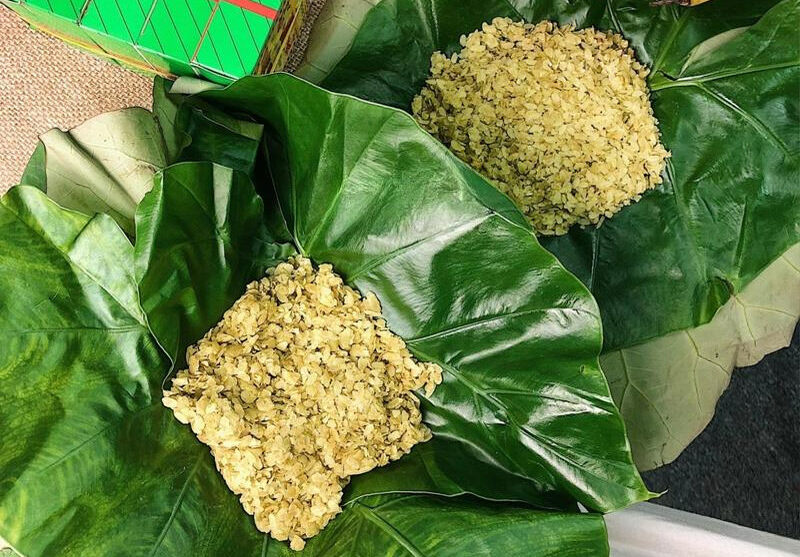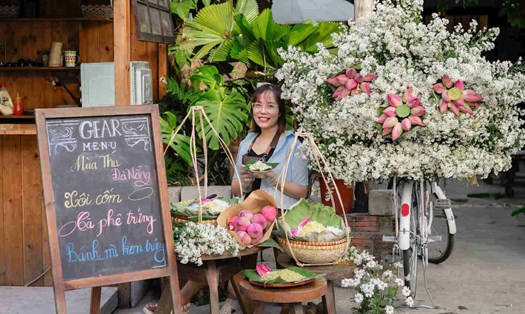When the cool breeze blows, spreading the scent of milk flowers throughout the streets of Hanoi, it is also the time when the gift of young rice - green rice flakes is sought after by many people. Among them, green rice flakes from Vong village is an autumn gift that carries the elegance of traditional Hanoi cuisine.
Com Vong originated from Vong village - formerly known as Hau village, Dich Vong commune, Tu Liem district, now Dich Vong Hau ward, Cau Giay district, Hanoi.
The craft of making green rice flakes in Vong village has been passed down through generations. The elders recount that one autumn a thousand years ago, when the rice began to curl, it rained heavily. Due to a crop failure, the villagers had to cut the young rice flowers, bring them home to dry and roast, and eat them gradually to stave off hunger. As time went on, the craft of making green rice flakes became more skillful, the green rice grains became greener, thinner, more flexible and fragrant, becoming a familiar snack every autumn.
Unexpectedly, this popular gift became a precious specialty presented to the kings of the Ly Dynasty (1009-1225). Com Vong was loved by many people and became a famous elegant dish of the people of Hanoi later on.

Ms. Nguyen Hoa Mo (32 years old), owner of the traditional green rice production facility of Vong village, shared: “The green rice profession has been passed down from generation to generation, I was almost born and raised with the profession. Green rice in Vong village is carefully selected from rice varieties, it must be young sticky rice, so when eaten, it will be softer and more fragrant than other types of green rice.”
The green rice season usually lasts from the 7th to the 10th lunar month. The process of making green rice is extremely elaborate and complicated. After harvesting, the glutinous rice is threshed, washed in water, and the plump grains are selected and then roasted in a cast iron pan. To maintain the heat, the stove for roasting green rice must be covered with 15cm thick coal slag on the top and 40cm thick at the bottom, but instead of burning with coal, firewood must be used to easily adjust the fire.
When roasting rice, you must pay attention to constantly adjusting the heat. Every 30 minutes, the roaster must try to pick up 5 grains and place them on a piece of wood, using their thumb to rub each grain hard. If they see “2 curls and 3 cracks” – meaning 2 grains have not peeled off the shell but curl up, 3 grains peeled off the shell but do not curl up – it is done.
After roasting, the rice is left to cool, then put into a mortar and pounded in batches of about 5kg. On the fifth pounding, the rice must be divided into 3 types: young rice, young rice, and old rice. In the last two times, the worker must pound each type separately.
Traditional Com Lang Vong is usually wrapped in two layers of leaves. The inner layer of taro leaves keeps the Com green, cool, and from drying out and losing its jade green color. The outer layer is lotus leaves, tied with straw from which all the rice has been stripped. Delicious Com grains have a jade-like color, are soft and fragrant, have a sweet taste, and the characteristic aroma of young sticky rice.

Referring to the pleasure of enjoying green rice, writer Thach Lam once wrote that it is not a food for people in a hurry, because "you have to eat little by little, slowly and thoughtfully".
Paired with green rice are bananas with egg-shaped leaves, usually bananas, more luxurious are bananas with royal leaves. The bananas are broken in half or cut into short pieces, dipped in green rice and eaten in small pieces, then chewed slowly. The harmonious combination of the sweetness and aroma of bananas and the softness of green rice seems to encapsulate the autumn flavor of Hanoi. Green rice can also be combined with lotus and coconut to make green rice sticky rice, stir-fried green rice, green rice sweet soup, moon cakes, etc.
Every autumn, along the roads at the gate of Vong village are small, pretty green rice baskets. In these simple baskets, it seems to encapsulate all the most quintessential, noble, and elegant things of Hanoi's autumn.

Ms. Hoa Mo revealed that green rice flakes sell best on the 15th day of the 8th lunar month - the time when customers buy them as gifts for relatives and friends during the Mid-Autumn Festival.
Com lang Vong costs about 250,000 - 300,000 VND/kg. Diners can buy standard-flavored com at Com lang Vong Ba Can (Xuan Thuy street, Cau Giay district), Com lang Vong Co Man (Dich Vong street, Cau Giay district)... or traditional com shops in Lang Vong.
In 2020, Com Lang Vong was granted a trademark registration certificate by the Ministry of Science and Technology.



